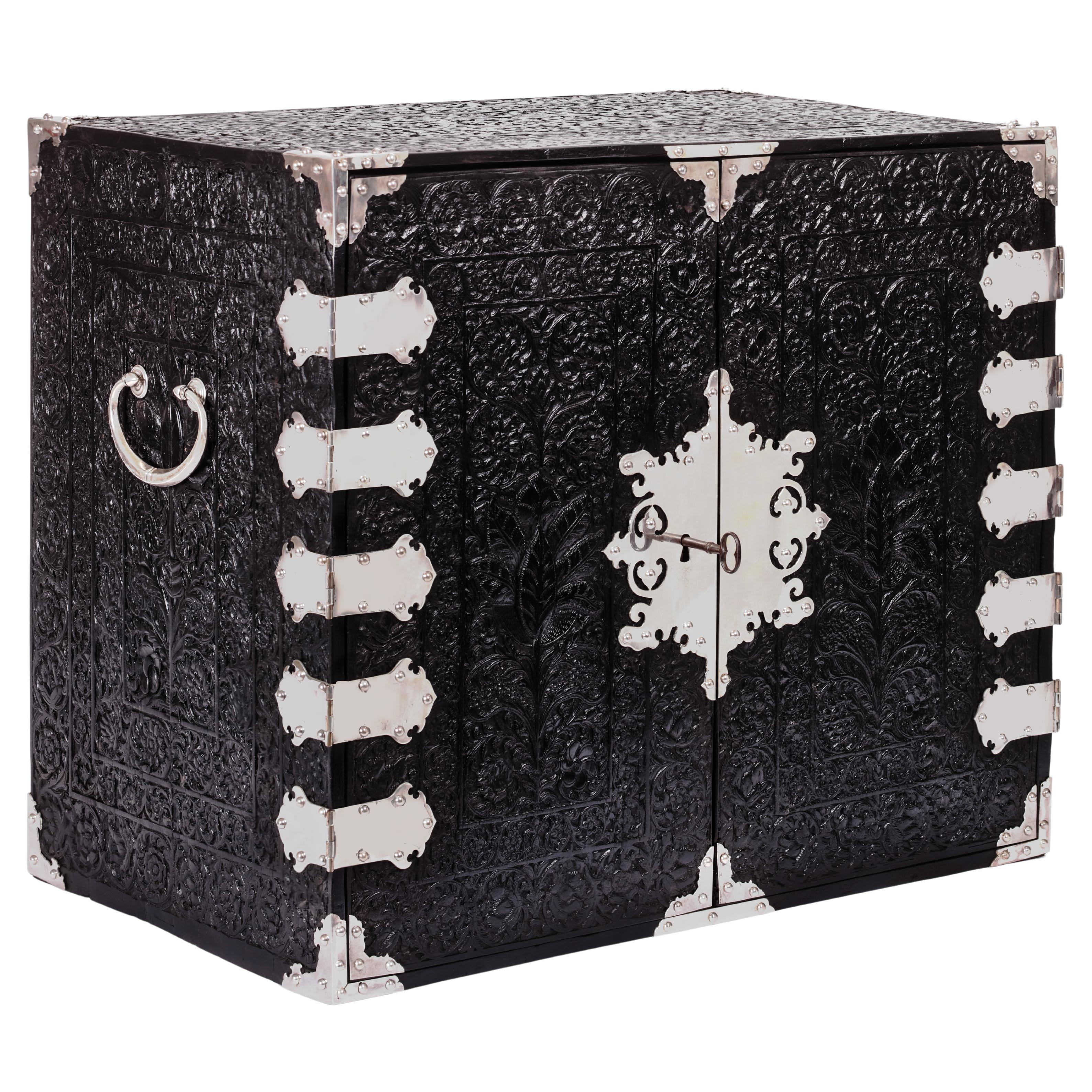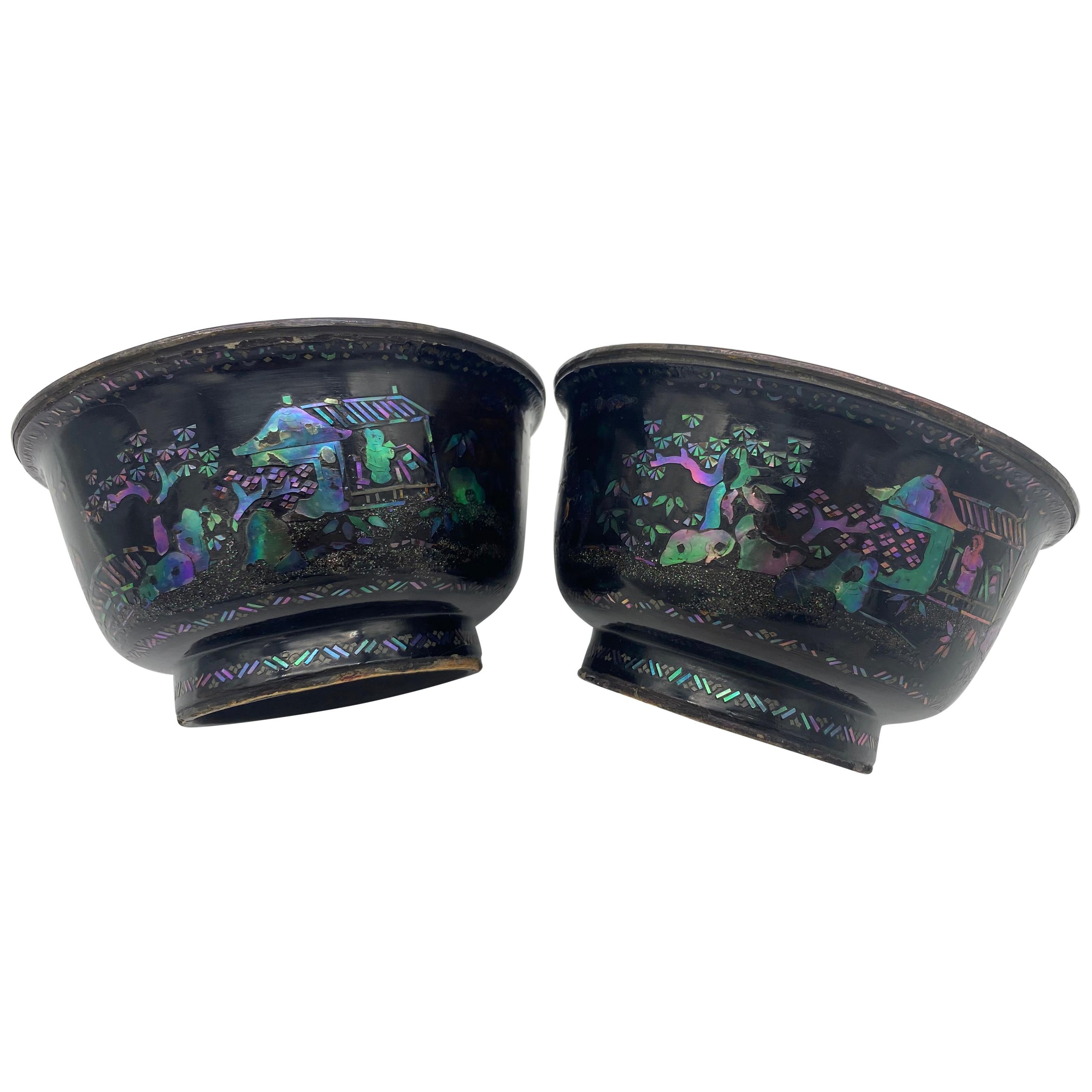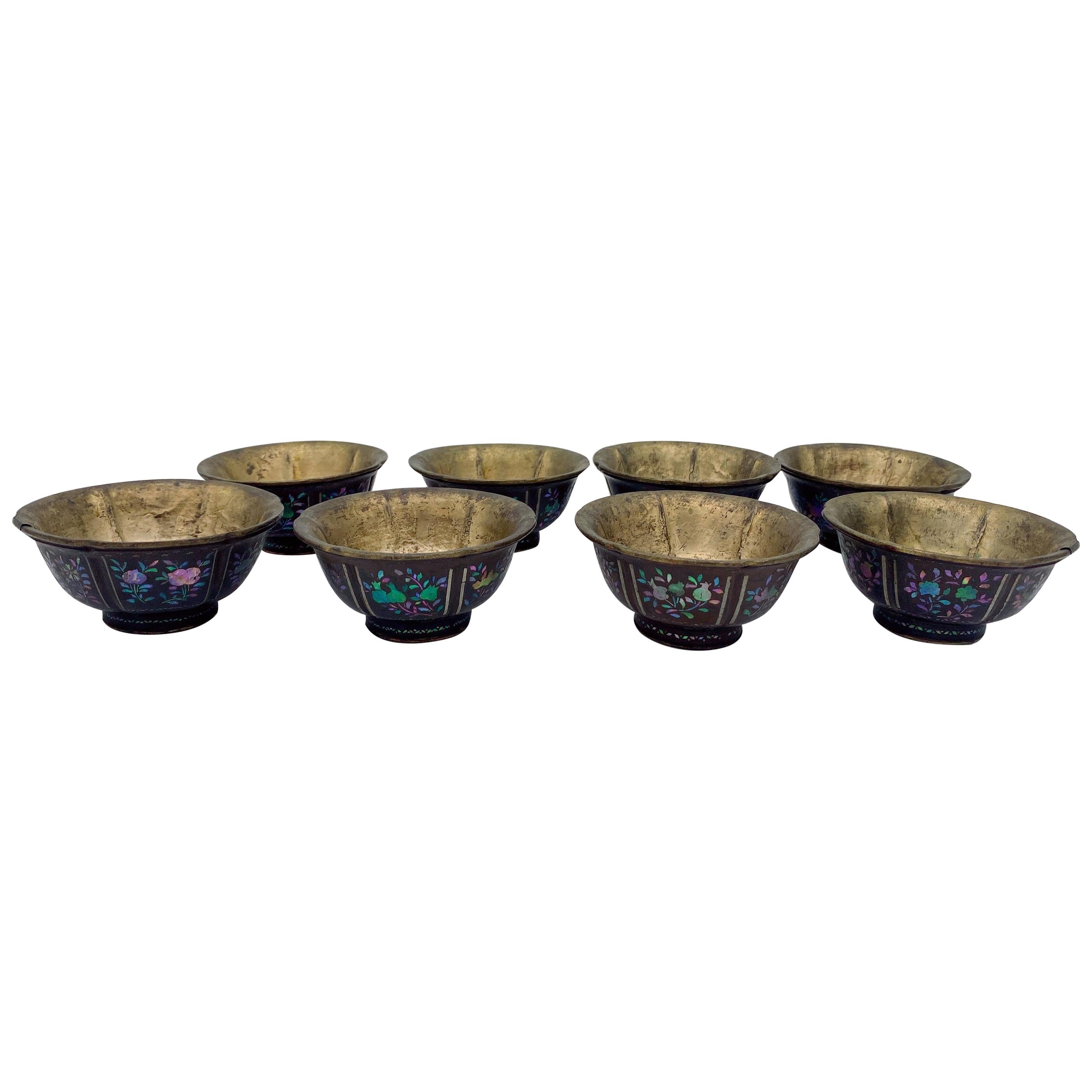Items Similar to 18th-century Dutch-colonial Peranakan mother-of-pearl casket with silver mounts
Want more images or videos?
Request additional images or videos from the seller
1 of 7
18th-century Dutch-colonial Peranakan mother-of-pearl casket with silver mounts
About the Item
An Indonesian Peranakan mother-of-pearl inlaid mastic sirih casket with silver mounts
Jakarta (Batavia), circa 1720-1730, the silver hinges marked for Batavia, maker’s mark HS or SH, part of the silver reconstructed
H. 10 x W. 26 x D. 17.5 cm
Before settling down to business in the former Dutch East Indies, sirih had to be offered in the most exquisite boxes, made of gold, silver, inlaid with precious stones, ivory, tortoiseshell, or, as the present one, inlaid with mother-of-pearl. The costliness of one’s sirih box displayed one’s fortunes.
In this manner, only one other sirih box in mother-of-pearl is documented. It is in the collection of Kip-Lee-Kip in Singapore (Peter Lee et al., Port Cities: Multicultural Emporiums of Asia, 1500-1900, Asian Civilizations Museum, Singapore, 2016, p.206, no. 166).
At least one of the previous owners of the casket presented here seemed to have been aware of the importance of this box since it possibly lost part of its silver but was restored with finely engraved openwork late 17th/early 18th century mounts. When observed closely, the box shows several nail holes all over, suggesting closed silver corner and centrepieces, and lock plate.
Researching a large number of sirih caskets, in design related and also for the Peranakan market, as this casket probably is, we asked a highly skilled restorer to design and reconstruct the missing silver mounts – with an astonishing result.
It is unknown who the silversmith HS or SH, active between circa 1714 and circa 1743, is, but he did leave an impressive oeuvre of a very high standard. The Kunstmuseum in The Hague has seven commemorative salvers, a walking stick and a cuspidor with these marks in the collection. For another and so far the latest dated salver by HS or SH, commemorating Bartha Helena van Suchtelen, born in Batavia (Jakarta) in 1710 and deceased there in 1743, see Uit Verre Streken, March 2013, no. 4.
- Dimensions:Height: 3.94 in (10 cm)Width: 10.24 in (26 cm)Depth: 6.89 in (17.5 cm)
- Style:Dutch Colonial (Of the Period)
- Materials and Techniques:
- Place of Origin:
- Period:
- Date of Manufacture:1720-1730
- Condition:Replacements made: The silver middle corner pieces, the center piece on the lid, lockplate and plates behind the hinges have been replaced by newly made pieces in style with the original silver mounts (corner pieces top and bottom and hinges) in 18th century silver. Wear consistent with age and use. Minor losses. Minor fading. Cleaned, some MOP pieces replaced, fragile material so in a good condition for the age.
- Seller Location:Amsterdam, NL
- Reference Number:1stDibs: LU5458231460622
About the Seller
5.0
Vetted Seller
These experienced sellers undergo a comprehensive evaluation by our team of in-house experts.
Established in 1985
1stDibs seller since 2020
19 sales on 1stDibs
Typical response time: 3 hours
- ShippingRetrieving quote...Ships From: Amsterdam, Netherlands
- Return PolicyA return for this item may be initiated within 7 days of delivery.
More From This SellerView All
- Fine Dutch Colonial Indonesian Casket with Silver Mounts, circa 1706Located in Amsterdam, NLA fine Indonesian Ambonya burl, ebony and teak casket with silver mounts Jakarta (Batavia), circa 1706 (year letter W (1705-1710), marked DV, probably Dirck Vooght The outer ri...Category
Antique Early 18th Century Indonesian Dutch Colonial Decorative Boxes
MaterialsSterling Silver
- A Dutch colonial ebony box with silver mountsLocated in Amsterdam, NLBatavia (Jakarta), or Sri Lanka, circa 1680-1720 The document or money box is densely carved with fine scrolling vines and lotus flowers. It has a charming heart- shapes silver lock...Category
Antique Late 17th Century Indonesian Dutch Colonial Antiquities
MaterialsSilver
- A 17th century Dutch-colonial ebony two-door VOC cabinet with silver mountsLocated in Amsterdam, NLA Dutch-colonial ebony two-door cabinet with silver mounts Coromandel Coast, probably Masulipatnam, circa 1650-1680, the silver later H. 64.5 x W. 75 x D. 46 cm The present cabinet...Category
Antique 17th Century Indian Dutch Colonial Antiquities
MaterialsSilver
- 16th-Century Indo-Portuguese Colonial Mother-of-pearl Gujarat CasketLocated in Amsterdam, NLAn exceptional Indo-Portuguese colonial mother-of-pearl veneered casket with silver mounts India, Gujarat, 2nd half of the 16th century, the silver mounts Goa or probably Lisbon Measures: H. 16 x W. 24.6 x D. 16.1 cm An exceptional Gujarati casket with a rectangular box and truncated pyramidal lid (with slopes on each side and a flat top) made from exotic wood, probably teak (Tectona grandis), covered with a mother-of-pearl mosaic. The tesserae, cut from the shell of the green turban sea snail (Turbo marmoratus, a marine gastropod) in the shape of fish scales, are pinned to the wooden structure with silver ball-headed nails. The casket is set on bracket feet on the corners. The masterfully engraved decoration of the silver mounts follows the most refined and erudite Mannerist repertoire of rinceaux and ferroneries dating from the mid-16th century. The high quality and refinement of the silver mounts and, likewise, the silver nails that replaced the original brass pins used to hold the mother-of-pearl tesserae in place indicate the work of a silversmith probably working in Lisbon in the second half of the 16th century. The Indian origin of this production, namely from Cambay (Khambhat) and Surat in the present state of Gujarat in north India, is, as for the last three decades, consensual and fully demonstrated, not only by documentary and literary evidence - such as descriptions, travelogues and contemporary archival documentation - but also by the survival in situ of 16th-century wooden structures covered in mother-of-pearl tesserae. A fine example is a canopy decorating the tomb (dargah) of the Sufi saint, Sheik Salim Chisti (1478-1572) in Fatehpur Sikri in Agra district in the state of Uttar Pradesh, north India. This is an artistic production, geometric in character and Islamic in nature, where usually the mother-of-pearl tesserae form complex designs of fish scales or, similar to the dishes also made using the same technique, with the thin brass sheets and pins, stylized lotus flowers. The truncated pyramidal shape corresponds, like their contemporary tortoiseshell counterparts also made in Gujarat, to a piece of furniture used in the Indian subcontinent within the Islamic world prior to the arrival of the first Portuguese. This shape, in fact, is very old and peculiar to East-Asian caskets, chests or boxes used to contain and protect Buddhist texts, the sutras. A similar chest is the famous and large reliquary chest from Lisbon cathedral that once contained the relics of the city's patron saint, Saint Vincent. Both match in shape, having the same kind of socle or pedestal and bracket feet, and in their engraved silver mountings, featuring the same type of refined, erudite decoration. Their differences lie in the silver borders that frame the entire length of the edges of the chest (both the box and the lid), pinned with silver nails, and on the lock plate, shaped like a coat of arms in the Lisbon example. Given the exceptional dimensions of the reliquary casket...Category
Antique 16th Century Indian Jewelry Boxes
MaterialsSilver
- A large Dutch colonial ebony cabinet with brass mountsLocated in Amsterdam, NLA Dutch colonial ebony cabinet with brass mounts on contemporary black steel frame Batavia (Jakarta), 2nd half 17th century The cabinet has two ...Category
Antique Mid-17th Century Indonesian Dutch Colonial Antiquities
MaterialsBrass
- 18th century Dutch-Colonial ‘Vizagapatam’ pen-engraved bone inlaid ebony boxLocated in Amsterdam, NLA large Indian Colonial ‘Vizagapatam’ pen-engraved bone inlaid ebony box Masulipatnam or Vizagapatam, 2nd half 18th century H. 10.8 x W. 47 x D. 34 cm ...Category
Antique Late 18th Century Indian Dutch Colonial More Asian Art, Objects ...
MaterialsBone, Ebony
You May Also Like
- 18th Century Pair of Chinese Silver Lacquer Bowls with Mother of Pearl InlaidLocated in Brea, CAPair of Chinese silver, lacquer, and mother of pearl big bowls from the 18th century. The faces each of a thin sheet of distressed silver over a body of black lacquered wood with mot...Category
Antique 18th Century Chinese Qing Lacquer
MaterialsLacquer
- 18th Century Pair of Chinese Silver Lacquer Bowls with Mother of Pearl InlaidLocated in Brea, CAPair of Chinese silver, lacquer, and mother of pearl burgaute "Bat " bowls, each inlaid in mother of pearl with bats in flight amongst stylized clouds between a band of cash to the r...Category
Antique 18th Century Chinese Qing Lacquer
MaterialsLacquer
- 18th Century Set of 8 Chinese Silver Lacquer Bowls with Mother of Pearl InlaidLocated in Brea, CAA fine set of 8 pieces Chinese lacquered and mother of pearl inlaid bowls with silvered interiors from the 18th century Qing Dynast...Category
Antique Early 18th Century Chinese Ming Lacquer
MaterialsLacquer
- 18th Century Small Black Jewelry ChestLocated in Dallas, TXThis old wooden chest was probably a jewelry box back in the day. It was painted in black then hand painted with decor and organic forms throughout. The two wooden front doors...Category
Antique 18th Century Asian Antiquities
MaterialsWood, Paint
- 18th Century Black Lacquer Mother of Pearl Inlay PlateLocated in Brea, CA18th century black lacquer mother of pearl inlay plate, decoration as expected for age and use. Very beautiful and hard to find li...Category
Antique Early 18th Century Chinese Qing Antiquities
MaterialsMother-of-Pearl
- European Chinese Export "Canton enamel" Oval Box, 18th CenturyLocated in Delft, NLAn European Chinese export "Canton enamel" oval box, 18th century Qianlong, (1736-1795) An enamel box with floral decor made for the export for Euro...Category
Antique 18th Century Chinese Antiquities
MaterialsCopper
Recently Viewed
View AllMore Ways To Browse
Dutch Gold
Mid Century Colonial
Silver Mother Of Pearl
Mother Of Pearl Art
Antique Dutch Plates
Antique Mother Of Pearl Inlay Furniture
Colonial 18th Century
Late 18th Century Dutch
Dutch Furniture Maker
Casket Century
Mark Dutcher
Lacquer Mother Of Pearl
Colonial Dutch
Asian Art Ivory
Asian Inlaid
Colonial Furniture Dutch
Dutch Display
Mother Of Pearl Plate





